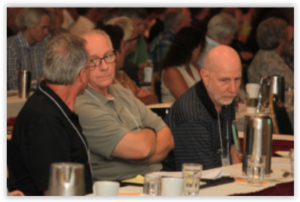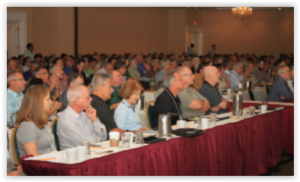To Stay Informed
AND ON TOP OF THE GAME
Continuing education is very important in my industry. And, successful Indoor Air Quality (IAQ) investigations rely heavily on the latest research and techniques. There is so much new research, and so many new tools and methods, that failing to attend some sort of class, workshop, or conference means that you might be working with obsolete information. And when that happens, your clients can suffer the unfortunate consequences. Consequently, staying informed has been a major goal since I started doing IAQ consulting.
 Continuing education is so important that in the early days of my career, I regularly attended a three-day IAQ conference in Tulsa, Oklahoma. At that time, there weren’t many places where you could get training or continue to educate yourself on IAQ, so most of the latest research and the biggest names in the industry were there. Over the past 25 years, additional research has been done, major contamination issues have been documented, and the issue of IAQ has moved to the forefront. As a result, today there are many, many resources that IAQ specialists can call on for continuing their education. One group that focuses exclusively on IAQ is the Indoor Air Quality Association (IAQA). Managed by ASHRAE, or the American Society of Heating, Refridgerating, and Air-Coniditioning Engineers, the IAQA holds local Houston workshops (I am the Chapter Director) offers online training events, and even sponsors a national conference. All great education opportunities!
Continuing education is so important that in the early days of my career, I regularly attended a three-day IAQ conference in Tulsa, Oklahoma. At that time, there weren’t many places where you could get training or continue to educate yourself on IAQ, so most of the latest research and the biggest names in the industry were there. Over the past 25 years, additional research has been done, major contamination issues have been documented, and the issue of IAQ has moved to the forefront. As a result, today there are many, many resources that IAQ specialists can call on for continuing their education. One group that focuses exclusively on IAQ is the Indoor Air Quality Association (IAQA). Managed by ASHRAE, or the American Society of Heating, Refridgerating, and Air-Coniditioning Engineers, the IAQA holds local Houston workshops (I am the Chapter Director) offers online training events, and even sponsors a national conference. All great education opportunities!
My favorite learning opportunity is an annual program that I attend in Massachusetts during August. It’s called the Westford Building Science Symposium. Originally billed as a chance to talk about building failures — and drink beer — the program has developed into one that focuses on the technology and physics of building design, construction, and other critical building issues. I have been attending this three-day program for 15 years now, and see it as the pinnacle of my learning by increasing my knowledge, understanding, and abilities to identify the sources of IAQ problems in all kinds of buildings. The conference, affectionately called Summer Camp, is now North America’s top source of specialized education on building construction techniques and failures.
Over the years I have learned that there are a lot of subjects and properties (of materials) that researchers and product manufacturers take for granted, but which architects, engineers, contractors, consultants (like me), and even building owners know little about. Understanding the issues related to the movement of heat, light, and moisture in a building’s slab, wall, or roof seems simple … but it turns out it isn’t. A prime example of this involves moisture.
Most people involved with building management have a good understanding of how water gets into buildings. They recognize that water comes in three different forms: liquid, solid, and vapor. Moreover, we all know that we can seal buildings to keep out ice and water. But vapor is the tough one! If the proper construction materials are not selected, or installed in the correct way, you can be letting in water vapor … and that is often hard to find and fix! And uncontrolled water vapor opens up a building’s structure to all kinds of failures.

That’s right, I’ve learned that we often don’t consider the vapor contained in the air leaks at windows — or around outlets or switches installed on the perimeter wall — because it can’t be seen. But that air leak also brings in vapor, which can condense on the inside surface of the wall. When that happens, things then start to deteriorate, and you won’t often see it until it’s too late!
Attending Summer Camp has given me a perspective on construction and building design that I would not have had otherwise. It gives me the opportunity to learn about the latest research and product details, and I get to speak with the experts directly involved. I have even taken advantage of the contacts made at Summer Camp to help me fix a few unusual or unique problems found in the field. And I have found that using the Summer Camp theories in a field environment is unbelievably satisfying!
Sometimes, the Summer Camp presentations are a bit “over my head,” but I love the challenge. Each year, I bring the handouts, reference documents, and my own handwritten notes home and scrutinize them. It can take days to understand the concepts, and may be months before I have a chance to use them, but it has been well worth the time invested. The more I understand about material properties, how buildings should be built, and how buildings can fail, the better I can identify the source of the issues occurring and successfully resolve indoor air quality problems.
I like the challenges presented at Summer Camp!
I enjoy hearing about problems and discovering solutions!
I love my job!

